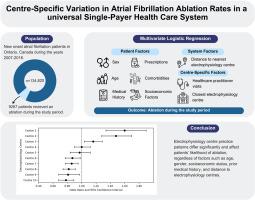Centre-Specific Variation in Atrial Fibrillation Ablation-Treatment Rates in a Universal Single-Payer Healthcare System
IF 2.5
Q2 CARDIAC & CARDIOVASCULAR SYSTEMS
引用次数: 0
Abstract
Background
Disparities in atrial fibrillation ablation rates have been studied previously, with a focus on either patient characteristics or systems factors, rather than geographic factors. The impact of electrophysiology (EP) centre practice patterns on ablation rates has not been well studied.
Methods
This population-based cohort study used linked administrative datasets covering physician billing codes, hospitalizations, prescriptions, and census data. The study population consisted of patients who visited an emergency department with a new diagnosis of atrial fibrillation, in the period 2007-2016, in Ontario, Canada. Patient characteristics, including age, sex, medical history, comorbidities, socioeconomic factors, closest EP centre within 20 km, and distance to the nearest centre, were used as predictors in multivariable logistic regression models to assess the relationship between living in a location around specific EP centres and ablation rates.
Results
The cohort included 134,820 patients, of whom 9267 had an ablation treatment during the study period. Patients undergoing ablation treatment were younger, had a lower Congestive Heart Failure, Hypertension, Age, Diabetes, Stroke/Transient Ischemic Attack (CHADS2) score, lived closer to EP centres, and had fewer comorbidities than those who did not receive ablation treatment. Wide variation occurred in ablation rates, with adjacent census divisions having ablation rates up to 2.6 times higher. Multivariate regression revealed significant differences in ablation rates for patients who lived in a location around certain EP centres. The odds ratios for living in a location closest to specific centres ranged from 0.78 (95% confidence interval: 0.68-0.89) to 1.60 (95% confidence interval:1.34-1.90).
Conclusions
Living near specific EP centres may significantly affect a patient’s likelihood of receiving ablation treatment, regardless of factors such as age, gender, socioeconomic status, prior medical history, and distance to EP centres.

全民单方付费医疗体系中心房颤动消融治疗率的中心差异
背景以前曾对心房颤动消融率的差异进行过研究,重点是患者特征或系统因素,而不是地理因素。这项基于人群的队列研究使用了关联的行政数据集,涵盖了医生账单代码、住院、处方和人口普查数据。研究对象包括 2007-2016 年期间在加拿大安大略省急诊科就诊并新诊断为心房颤动的患者。在多变量逻辑回归模型中,患者的年龄、性别、病史、合并症、社会经济因素、20公里内最近的心房颤动中心以及与最近中心的距离等特征被用作预测因素,以评估居住在特定心房颤动中心周围地区与消融率之间的关系。与未接受消融治疗的患者相比,接受消融治疗的患者更年轻,充血性心力衰竭、高血压、年龄、糖尿病、中风/短暂性脑缺血发作(CHADS2)评分更低,居住地更靠近 EP 中心,合并症更少。消融率的差异很大,相邻人口普查分区的消融率最高高出 2.6 倍。多变量回归显示,居住在某些 EP 中心周围地区的患者的消融率存在显著差异。结论无论年龄、性别、社会经济地位、既往病史和与 EP 中心的距离等因素如何,居住在特定 EP 中心附近可能会显著影响患者接受消融治疗的可能性。
本文章由计算机程序翻译,如有差异,请以英文原文为准。
求助全文
约1分钟内获得全文
求助全文
来源期刊

CJC Open
Medicine-Cardiology and Cardiovascular Medicine
CiteScore
3.30
自引率
0.00%
发文量
143
审稿时长
60 days
 求助内容:
求助内容: 应助结果提醒方式:
应助结果提醒方式:


